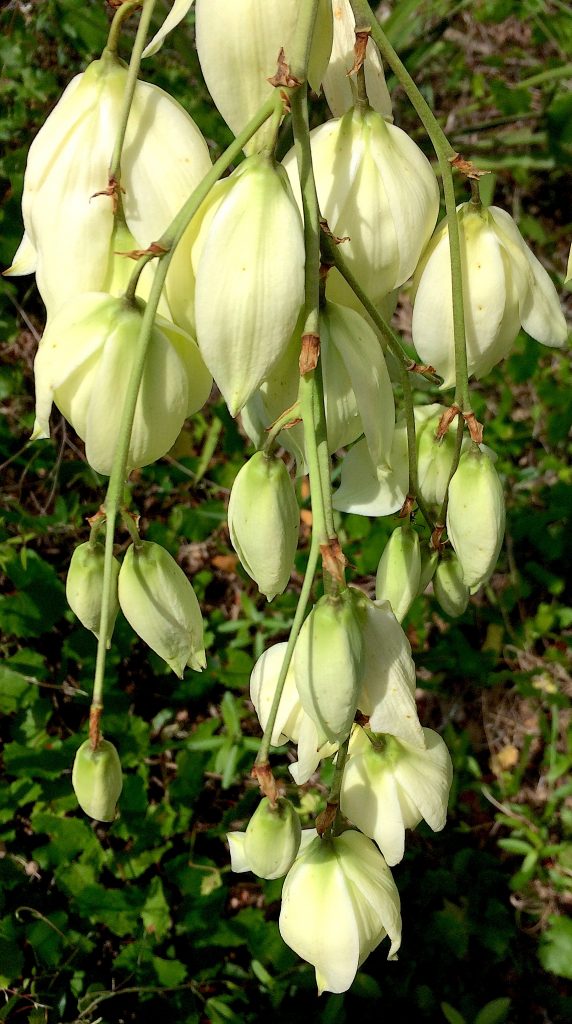
Our Yucca blossoms need to be cooked. Photo by Green Deane
Yucca is not Yuca. Or said another way: YOU-ka is not YUK-ka. The latter, Yuca with on ‘C’, is a root that is edible after some processing. Yucca — with two ‘C’s’ has roots that are not edible. They are bitter, soapy, and used to stun fish. So what do we eat on the Yucca? The flowers, the flower stem when young, and some folks can stomach the seeds. The plant is also deer proof.
Also called Spanish Bayonet, Needle Palm, Bear Grass, and Adam’s Needle, it is actually a broadleaf, evergreen shrub. It was originally a southern species but now can be found as far north as southern New England. Interestingly Yucca is not found in south Florida or the Keys. Unlike many other Yucca species its edible uses are limited. Other species, with far less bitter saponins, have edible fruit which lends itself to many uses. What it lacks in edibility the Yucca filimentosa mades up for in producing fiber. It is blossoming now. A good place to look is drier pastures and clearings in upland woods. To read more about the Yucca, go here.
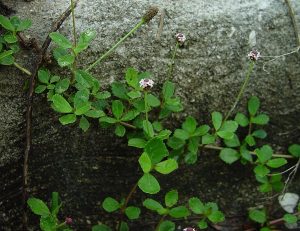
Matchhead also called Frog Fruit
Some plants barely make it into the realm of edible. For example it if it not toxic, does not taste bad, and grows in profusion it’s probably an edible. However, as forager emeritus Dick Deuerling used to say, “I only eat the good stuff.” Whether Frog Fruit, also known as Match Head, is “good stuff” is debatable. You can boil the leaves to eat , dry them for tea, or in a pinch smoke them most likely to keep bugs from finding you. Most often you will find Match Head/Frog Fruit in lower, wetter spots of a lawn. While it is not a great wild edible one of it’s relative, Lippia alba aka Oaxaca Lemon Verbena, is. I have it growing in my dry back yard. All of that reminds me of a “nudiflora” that also barely makes it into the edible realm, Murdannia nudiflora, or Doveweed. It’s related to the Commelina family and likes damp spots like the Match Head. To read about Doveweed go here.
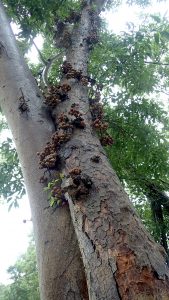
Ficus racemosa. Photo by Green Deane
Both Palm Beach (thus West Palm Beach) and Dreher Park have an interesting history. Palm Beach got its name from an argument over insurance followed by one big party. You can read about it here. Dreher Park’s creation was covered in this newsletter last year. The park has many unusual species because (Paul) Dreher wasn’t given a budget to make the land into a park. He took donations and even raided landscaping trash heap. Thus it has an eclectic mixture of species. One tree it has is a Ficus racemosa, the Cluster Fig. (What I don’t know is whether this species has varieties and different colored figs.) The tree produces figs on special shoots from the trunk and main branches. The fruit is edible raw or cooked but does not have much of a flavor — nor do Banyan figs. Often the fruit is striped when totally ripe. Young leaves are cooked as well, shoots are cooked or eaten raw. Interestingly, a relative, the Rubber Tree, has edible tips and fruit. You can read more about the Fig Family here.
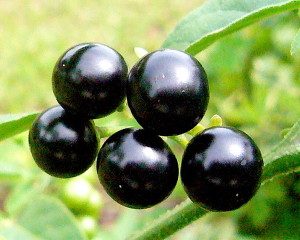
The Black Nightshade has shiny berries. Photo by Green Deane
Here, there, everywhere, you can find American Nightshade ripe with fruit. It likes sunny places but don’t rule out spots under trees that also get enough passing sun. Overly wet areas are not good. One often finds them along with Bidens alba, also known as Spanish Needles. From a pile of dirt in West Palm Beach to a bike trail north of Orlando we found plenty of ripe American Nighshades this weekend to snack on (often, oddly, peering out from under a monsoon umbrella.) Yes, the green, unripe berries are toxic, they can make you sick if you eat many unripe berries, less for children who are more often poisoned than adults. They don’t know green berries taste bad and they eat a lot of then. Symptoms occur within 30 minutes and pumping out the stomach usually leads to recovery. That said, fatal poisoning are rare with the only death reported as far back as 1866. So don’t eat unripe green berries. Don’t eat berries that are partially green or purple. Total purple on the outside is what you want. To read more about the American Nightshade go here.

Classes are held rain or shine.
Foraging Classes: A hearty thank you to the folks who braved Tropical Storm Alberto’s rains for a foraging class in West Palm Beach Sunday. Saturday’s class was cancelled not because of rain — it was a fine day — but because of flooding in the back of LaStrange Preserve. They county said if we parked outside the park the police might haul our cars away.
Saturday, June 2nd, Red Bug Slough Preserve, 5200 Beneva Road, Sarasota, FL, 34233, 9 a.m.
Sunday June 3rd, Colby-Alderman Park: 1099 Massachusetts Street, Cassadaga. Fla. 9 a.m., meet near the restrooms.
Saturday, June 9th, Blanchard Park, 10501 Jay Blanchard Trail, Orlando, FL 32817. 9 a.m. Meet at the pavilion east of the tennis courts near the YMCA.
Sunday, June 10th, Boulware Springs Park, 3420 SE 15th St., Gainesville, FL 32641. Meet at the picnic tables next to the pump house, 9 a.m.
Saturday, June 16th, Florida State College, south campus, 11901 Beach Blvd., Jacksonville, 32246, 9 a.m.
Sunday, June 17th, Wickham Park: 2500 Parkway Drive, Melbourne, FL. 9 a.m. Meet at the dog park.
Sunday June 24th, John Chestnut County Park: 2200 East Lake Road, Palm Harbor, FL 34685. Meet at the trail head of the Peggy Park Nature Walk, pavilion 1 parking lot. 9 a.m.
Saturday, June 30th, George LeStrange Preserve, 4911 Ralls Road, Fort Pierce, FL, 34981. 9 a.m.
Sunday July 1st is a tentative Orlando Mushroom Group mushroom hunt. Time and location to be announced.
To learn more about the classes go here.

Green Deane DVD set of 135 videos
All of Green Deane’s videos available for free on You Tube. They do have ads on them so every time you watch a Green Deane video I get a quarter of one cent. Four views, one cent. Not exactly a large money-maker but it helps pays for this newsletter. If you want to see the videos without ads and some in slightly better quality you can order the DVD set. It is nine DVDs with 15 videos on each. Many people want their own copy of the videos or they have a slow service and its easier to order then to watch them on-line. They make a good gift for that forager you know. Individual DVDs can also be ordered. You can order them by clicking on the button on the top right of this page or you can go here.

Green Deane Forum
Want to identify a plant? Looking for a foraging reference? Do you have a UFO, an Unidentified Flowering Object you want identified? On the Green Deane Forum we chat about foraging all year. And it’s not just about warm-weather plants or just North American flora. Many nations around the world share common weeds so there’s a lot to talk about. There’s also more than weeds. The reference section has information for foraging around the world. There are also articles on food preservation, and forgotten skills from making bows to fermenting food. One special section is “From the Frightening Mail Bag” where we learn from people’s mistakes. You can join the forum by clicking on the button in the menu line.
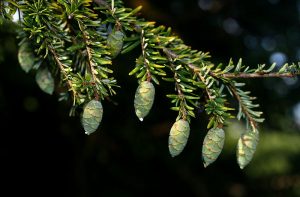
Tsuga canadensis. We just called it a fir tree.
The fir tree called the Easter Hemlock (Tsuga canadensis) has edible parts. It was also what we used for a Christmas Tree every year. I’d take an ax and head out into the 120 acre chunk of forest behind the house and find a suitable one. And it is called “eastern” for a reason: You won’t find it west of mid-continent. On the edible side young needles are used to make a tea and the inner bark is edible as well. The tree is also quite threatened and down to 1% presence in some places compared to when Europeans first arrived to the New World. One reasons is many areas of the country are overpopulated by deer and their urine is threatening the tree’s future. Deer like to nibble on the Eastern Hemlock. They know a good thing when they taste it. Their urine, however, is high in nitrogen and hemlocks like low nitrogen soil plus they are slow growing. Trees such as the sugar maple, however, like high-nitrogen soil so they are moving in and outgrowing hemlocks. (Don’t confuse the tree called the hemlock with a green herbaceous plant call the hemlock, which is deadly.) And while permaculture is a related speciality and not my area of competency it might be nice to have a cute deer or two in the back yard to recycle “garden waste” and make nitrogen…
This is weekly issue 306.
If you would like to donate to Eat The Weeds please click here. Or you can use my Go Fund Me link, or by writing to Green Deane POB 941793 Maitland FL, 32794.


Hi, I’m from san diego, I will be in Miami from June 19 to 26th. I would like you join you for the hike on the 24th of june. Please add me to the list.
On that date my class is in New Port Richey, which is some 300 miles from Miami.
Sir, I’ve grown a Ficus Carica fig tree in my back garden . It fruited once for the first time and never again now that more than a year has lapsed. Truely I had’nt seen any blossoms ever since nursing the tree from seed. That lonely harvest I had obtained was a few very small fruits. I’m thinking of cutting it down altogether and make use of the place. Pleased to have your advice – many thanks.